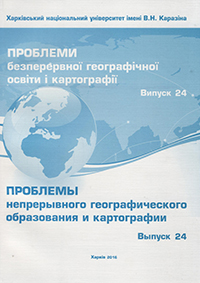Sustainable development indicators and possibilities of their mapping
Анотація
The article deals with the sets of sustainable development indicators and sustainable development indexes. Among approaches used in indicators design the author has identified geosystemic, target, problematic, sectoral and functional ones. It is denoted that the most widely used indicator sets are the OECD programme on ecological indicators and the system of indicators created by the UNO Division for Sustainable Development. The author analyzes the integral indexes of sustainable development, such as Living Planet Index, Human Development Index, Human Poverty Index, Adjusted Net Savings and the Ecological Footprint. It is emphasized that integral indicators and indexes are rarely used in sustainable development strategies (the reason for this could be some methodological limitations or lack of statistical data). The analysis of national sustainable development strategies of European countries has showed that the target approach is mainly used in the development of indicators and their number vary from 32 (Estonia) to 610 (Latvia). Sustainable development strategies indicators are expressed in the text and table forms; charts and graphs are commonly used in the monitoring reports, whereas cartographic works are hardly represented. The author has presented the following key recommendations for mapping indicators for sustainable development strategies: to use component system of indicators as the basis for integral indicators design; to use either territory or population as a «common denominator » for indicators; to give users the most complete picture of the territory development applying the least possible number of maps; to use collation and diagram maps which are the most appropriate way of cartographic representation.Завантаження
##plugins.generic.usageStats.noStats##
Посилання
1. Grechko, T.K., Lisovs`ky`j, S.A., Romanyuk, S.A, Rudenko, L.G. (2015). Publichne upravlinnya v zabezpechenni stalogo (zbalansovanogo) rozvy`tku [Public administration in sustainable development]. Xerson: Grin’ D.S., 94-106.
2. Zerkalov, D.V. (2013). Problemy` ekologiyi stalogo rozvy`tku [The problems of sustainable development ecology]. Ky`yiv: Osnova, 30-37. Available at: http://www.zerkalov.kiev.ua/sites/default/files/
3. Naukovi zasady` rozrobky` strategiyi stalogo rozvy`tku Ukrayiny` [Scientific principles of creating sustainable development strategy of Ukraine] (2012). Odesa: IPREED NAN Ukrayiny`, 418-429.
4. Peresad’ko, V., Popovych, N. (2016). Ispol’zovanie kartograficheskogo metoda v issledovanii strategij ustojchivogo razvitija stran Evropy [The use of cartographic method in the study of sustainable development strategies of European countries]. Scientific Letters of Academic Society of Michal Baludansky, 4 (1), 136-139.
5. Tikunov, V.S., Capuk, D.A. (1999). Ustojchivoe razvitie territorij: kartografo-informacionnoe obespechenie [Sustainable development of territories: cartography and GIS support]. Moskva – Smolensk: Izd. SGU, 92-109.
6. Utkina, K.B., Peresad’ko, V.A., Nekos, A.N., Popovy`ch, N.V. (2015). Stan i perspekty`vy` povodzhennya z vidxodamy` v ramkax rozroblennya strategiyi rozvy`tku Xarkivs`koyi oblasti do 2020 roku [The current state and prospects of waste management in the framework of preparation of the development strategy for Kharkiv oblast for the period until 2020]. Ukrainian geographical journal, 4 (92), 58-63.
7. European Comission. Beyond GDP. Available at: http://ec.europa.eu/environment/beyond_gdp/2007_conference_en.html
8. Steurer, R., Hemetner, M. (2013). Objectives and Indicators in Sustainable Development Strategies: Similarities and Variances across Europe. Sustainable Development, 21, 224-241.
9. UNCED. United Nations Conference on Environment and Development. Agenda 21. United Nations Organization: New York, 1992. Available at: https://sustainabledevelopment.un.org/
2. Zerkalov, D.V. (2013). Problemy` ekologiyi stalogo rozvy`tku [The problems of sustainable development ecology]. Ky`yiv: Osnova, 30-37. Available at: http://www.zerkalov.kiev.ua/sites/default/files/
3. Naukovi zasady` rozrobky` strategiyi stalogo rozvy`tku Ukrayiny` [Scientific principles of creating sustainable development strategy of Ukraine] (2012). Odesa: IPREED NAN Ukrayiny`, 418-429.
4. Peresad’ko, V., Popovych, N. (2016). Ispol’zovanie kartograficheskogo metoda v issledovanii strategij ustojchivogo razvitija stran Evropy [The use of cartographic method in the study of sustainable development strategies of European countries]. Scientific Letters of Academic Society of Michal Baludansky, 4 (1), 136-139.
5. Tikunov, V.S., Capuk, D.A. (1999). Ustojchivoe razvitie territorij: kartografo-informacionnoe obespechenie [Sustainable development of territories: cartography and GIS support]. Moskva – Smolensk: Izd. SGU, 92-109.
6. Utkina, K.B., Peresad’ko, V.A., Nekos, A.N., Popovy`ch, N.V. (2015). Stan i perspekty`vy` povodzhennya z vidxodamy` v ramkax rozroblennya strategiyi rozvy`tku Xarkivs`koyi oblasti do 2020 roku [The current state and prospects of waste management in the framework of preparation of the development strategy for Kharkiv oblast for the period until 2020]. Ukrainian geographical journal, 4 (92), 58-63.
7. European Comission. Beyond GDP. Available at: http://ec.europa.eu/environment/beyond_gdp/2007_conference_en.html
8. Steurer, R., Hemetner, M. (2013). Objectives and Indicators in Sustainable Development Strategies: Similarities and Variances across Europe. Sustainable Development, 21, 224-241.
9. UNCED. United Nations Conference on Environment and Development. Agenda 21. United Nations Organization: New York, 1992. Available at: https://sustainabledevelopment.un.org/
Як цитувати
Popovych, N. (1). Sustainable development indicators and possibilities of their mapping. Проблеми безперервної географічної освіти і картографії, (24), 135-139. вилучено із https://periodicals.karazin.ua/pbgok/article/view/6424
Номер
Розділ
Статті





